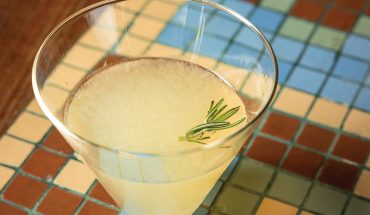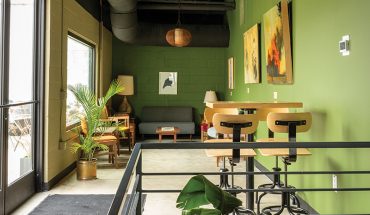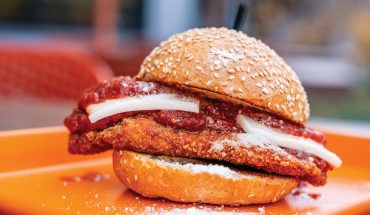Ramen and sushi at Sono
by Laura White
photography by Trey Thomas
If you haven’t been to Sono in the past year, it’s safe to say you haven’t been to Sono. Twelve months into his post as executive chef, Hyun-woo Kim’s love of fresh fish and culinary emprise has revitalized the downtown Raleigh Japanese and sushi restaurant. The decade-old spot has gotten a face-lift, a refined menu, and a revised philosophy for slaking the cravings of sushi lovers downtown. Located inside the first floor of the historic Hudson condo building, Sono opened on Fayetteville Street in 2008, not long after the street itself had reopened to vehicle traffic. Chef Mike Lee was the owner then, and under his guidance Sono stood the test of time on a street that saw many restaurants come and go. A decade is a long time, after all. When Lee stepped away last year to focus on his Durham concepts M Sushi and M Kokko, Chef Hyun-woo Kim stepped in, and over the past year he has been quietly and lovingly making Sono his own, culling and reshaping the menu to reflect his personal and professional heritage.
Style setting
Originally from Seoul, South Korea, Kim came to the U.S. 14 years ago when his sister, who was attending UNC-Chapel Hill at the time, went home for a visit. She suggested Kim and his new wife join her in the States; he sold his restaurant in South Korea and did just that.
After arriving in the Triangle, Kim worked in a number of restaurants, including Mura in North Hills. Eventually, he became the sushi chef at An Cuisines, a fine-dining Asian restaurant in Cary, where he worked under James Beard Foundation semifinalist Steven Greene. An closed in January 2017 and in February 2017, Kim went to downtown Raleigh. Taking over a restaurant can be a challenging task, Kim says. “I tried to make it my style. It had been eight years that they were running the restaurant before I came here; I could not change everything at one time.”
So he set about to make gradual but impactful shifts. After the first three months, he changed the menu a little bit and let it settle. After another three months, he changed the menu a bit more. He culled the sushi list from more than 35 specialty rolls to 15 or so, introduced his own ramen recipe, and eliminated some of the appetizer dishes, like tempura shrimp, for a more limited and refined menu with higher-quality items. It seemed to be going well. Then, he changed the ramen recipe. “So many people complained after that. It was really hard,” Kim says. But he steeled himself to stay his course. “I had to speak to my style. ”
Luckily, Kim is no stranger to figuring things out in media res. He earned his stripes in the kitchen, where he began working at the age of 17. He didn’t know what he was good at, or what he wanted to do, but he knew he wanted to work. It turned out that kitchen life was the right one for him, and every six months to a year he would switch things up in an effort to learn as much as possible, moving from Korean to Japanese to Thai to Italian cuisine. He opened his own restaurant in Korea at the age of 25.
Small batch
When he began working with sushi, Kim knew he’d found his place. In the beginning, though, he was nowhere near the fish. “When I started work, I just washed dishes and then washed the rice for one year – just that,” Kim says. One day a higher-level chef asked him, “Can you clean up this one?” Finally, he was able to get his hands on the fish. Flash forward 18 years, and Kim, at 39, tastes each and every fish he serves; he teaches his staff to do the same. “It’s very important. Sometimes they’ll ask me: ‘Can I use this one?’ Try it. If you don’t like it, if you don’t think it’s fresh, don’t use it,” Kim says. “Why? Because if you don’t like it, the customer won’t like it. If you don’t like it and the customer doesn’t like it, why would you use it?”
And Kim isn’t afraid to send the fish back if it isn’t up to his standards; he’d rather “86” (restaurant-speak for nix) an item than serve something he doesn’t consider up to par. One recent weekend, for instance, he received an order of two yellowtail but he didn’t like one of them, so he returned it. Before the weekend was up, the restaurant ran out, but serving the fish was never even a question. “There’s no choice,” Kim says. Kim’s head-to-tail approach to seafood guides his philosophy, and he sources the freshest possible sushi-grade fish, avoiding frozen at all costs.
While you can quite literally taste Sono’s dedication to fresh fish, the restaurant also offers a comprehensive lunch and dinner menu inspired by Kim’s own culinary heritage, including his twice-fried Korean fried chicken made with 15 spices, pan-fried dumplings, and tableside Ishiyaki BBQ.
And about that ramen. During his two decades in the kitchen, this is the recipe Kim has been perfecting (just last year he did some serious reconnaissance work in Japan). Sono now offers five variations of the soup based on two house-made broths: a pork-based Tonkotsu, and the pork, chicken, and katsuo (skipjack tuna) Shoyu.
The Tonkotsu ramen is a milky broth made with black garlic oil and cuts of tender pork chashu floating in a nest of curly ramen noodles. It is salty and savory, and just the thing for a chilly day. The Spicy Miso ramen is a zesty spin on the Tonkotsu, bright red in color, with just the right amount of heat.
The ramen broth is made fresh in 20-gallon batches every four or five days; the Tonkotsu is a 16-hour process, while the Shoyu cooks for about five. Sono sells over a thousand bowls of ramen a month, but Kim plans to keep the menu options limited.“If we had more kinds, it is hard to control the quality.”
And that quality is critical for Chef Kim and his crew. While they have been refining and fine-tuning the food menu, they’ve also been working to drastically expand their alcohol selection. They now offer one of the region’s largest saké programs at 38 bottles, both small and large format, and their wine list grew from 6 bottles to 90, with 15 available by the glass. The last Tuesday of every month you can get a taste of all these bottles at their Wine & Saké Social; from 5 p.m. to 6:30 p.m., $10 gets you a sample of one or two wines, several sakés, and snacks.
Over the years, Kim has worked across a host of different environments. He says the switch to Sono has been one of the most exciting. He revels in the big-city vibe, the casual elegance, and the diversity of his downtown guests. After work, he can often be found walking the streets and people watching, exploring his community; he’s excited to see where
Raleigh’s growth takes the restaurant, takes him.








